From OkomeraReviewed by Olivia Frost
This article and associated images are based on a poster originally authored by T Duboys, K Bergerhoff, E Coquerel, P Ananthanarayanan, J Wenda, A Dechelette, G Mary, MN Bellazrak, A Kumar, RFX Tomasi and Lucile Mercier and presented at ELRIG Drug Discovery 2025 in affiliation with Okomera.
This poster is being hosted on this website in its raw form, without modifications. It has not undergone peer review but has been reviewed to meet AZoNetwork's editorial quality standards. The information contained is for informational purposes only and should not be considered validated by independent peer assessment.

Abstract
Founded in 2020 at École Polytechnique and Institut Pasteur, Okomera aims to improve the predictivity of preclinical testing and accelerate oncology drug discovery. Okomera’s technology scales organoid assays through a benchtop platform combining microfluidics, biology, and AI, enabling reproducible organoid formation and clinically relevant testing from minimal tissue. It supports drug screens on fresh tumor biopsies and Patient derived Organoids (PDO) as well as Target validation studies for drug discovery.
Here, the team presents some use cases of Okomera’s target validation platform: Lentiviral transduction of GFP followed by RNA extraction and subsequent RT-qPCR, lentiviral transduction of Cas9 and a gRNA targeting ERS1 with subsequent DNA extraction and Sanger sequencing for knock-out QC and a drug screen.
Assay workflow

Image Credit: Image courtesy of T Duboys et al., in partnership with ELRIG (UK) Ltd.
Quantification of lentiviral transduction with GFP
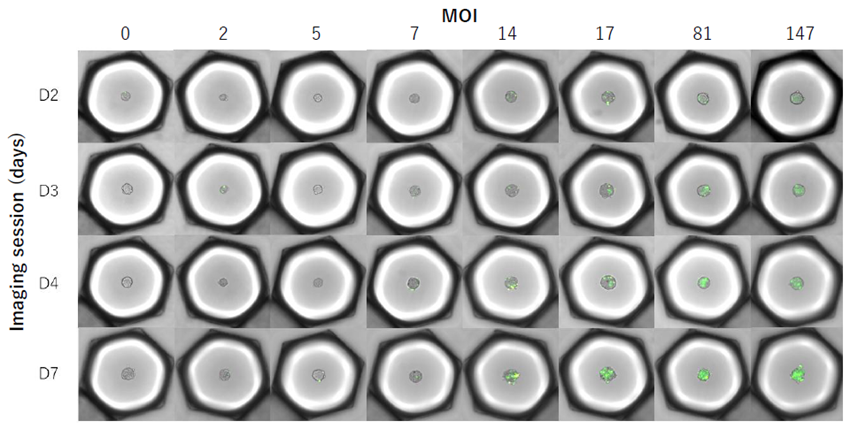
Figure 1. OKOMERA AI-Based Time-Lapse Overview of MCF7 spheroids across different MOIs. Increasing GFP fluorescence in most of the spheroid area is observed with increasing MOI. Representative traps are shown over time, with GFP signal in green. Image Credit: Image courtesy of T Duboys et al., in partnership with ELRIG (UK) Ltd.

Figure 2. GFP-positive spheroid surface area. Represents the proportion of the spheroid surface showing GFP signal, indicating transduction efficiency. No significant GFP increase was observed below an MOI of 17, suggesting limited transduction at lower doses. GFP areas at MOI 81 and 147 were similar, indicating full transduction of cells at MOI 81 and above. Image Credit: Image courtesy of T Duboys et al., in partnership with ELRIG (UK) Ltd.
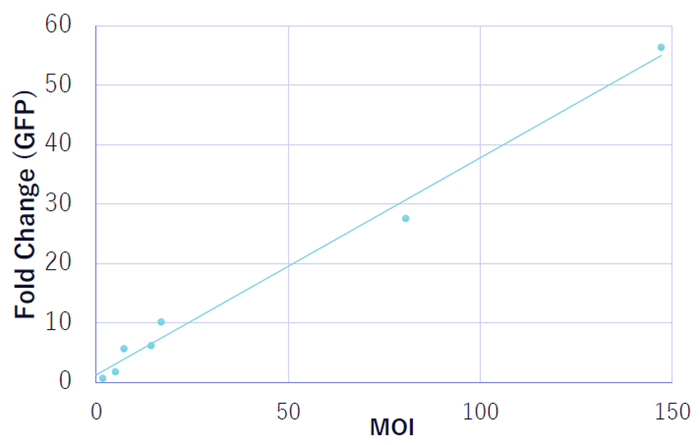
Figure 3. Fold change and linear regression fit (R2 = 0.9895) in GFP expression in MCF7 cells transduced with LV of different MOIs. A clear positive and near-linear relationship between MOI and GFP expression is observed. Image Credit: Image courtesy of T Duboys et al., in partnership with ELRIG (UK) Ltd.
QC of ESR1 K-O via Sanger sequencing

Figure 4. Sanger sequencing analysis of CRISPR-edited and control alleles. Sanger sequencing traces showing wild-type and CRISPR-edited samples at the target locus. The black underline marks the gRNA sequence, the red underline the PAM site, and the dashed line the Cas9 cut site. Mixed peaks in the edited trace indicate indels from NHEJ repair. Image Credit: Image courtesy of T Duboys et al., in partnership with ELRIG (UK) Ltd.

Figure 5. Analysis of inferred sequence contributions following CRISPR editing. This figure shows the allelic variants and their relative proportions in the edited population. Each sequence represents a distinct indel or mutation from Cas9 activity. The black dotted line marks the predicted cut site, and the wild-type sequence is denoted by WT. Image Credit: Image courtesy of T Duboys et al., in partnership with ELRIG (UK) Ltd.
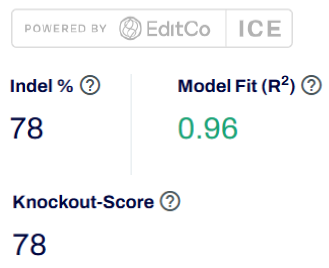
Image Credit: Image courtesy of T Duboys et al., in partnership with ELRIG (UK) Ltd.
INDEL %: Proportion of sequences differing from the wild-type control, indicating editing efficiency.
Knockout score: Percentage of edits predicted to disrupt gene function (frameshift or ≥21 bp indel).
Model fit (R2): Indicates how well the ICE model fits the data; higher values show greater confidence in editing estimates.
Drug screen
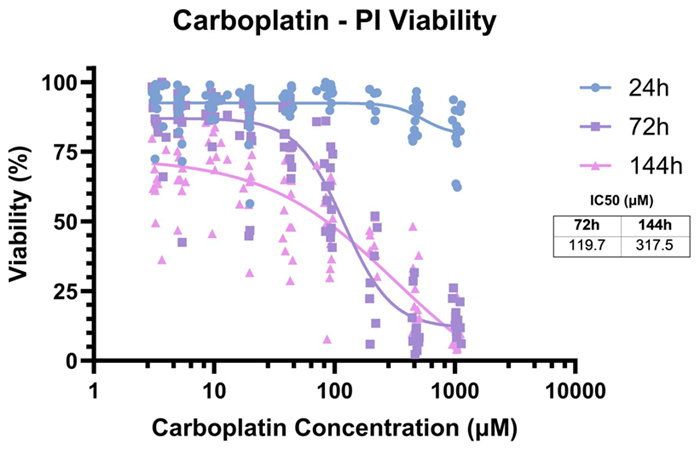
Figure 6. Dose-response curves for carboplatin treatment of MCF7 spheroids on a microfluidic chip. Cell viability at 24 hours (blue), 72 hours (purple), and 144 hours (pink), showing time-dependent drug sensitivity. Viability was calculated as the ratio of the spheroid area with a PI signal above the death threshold to the total area. Image Credit: Image courtesy of T Duboys et al., in partnership with ELRIG (UK) Ltd.
About Okomera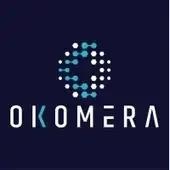
Okomera is a biotech start-up that accelerates access to improved, precision-based cancer therapies, pioneering automation, and miniaturization of personalized tumor biopsy studies.
It integrates standard assays on chip (e.g., CRISPR, T-cell, cytotoxicity) to accelerate drug discovery from target to validation and advance preclinical predictivity.
About ELRIG (UK) Ltd.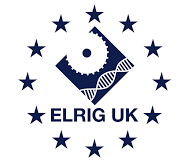
The European Laboratory Research & Innovation Group (ELRIG) is a leading European not-for-profit organization that exists to provide outstanding scientific content to the life science community. The foundation of the organization is based on the use and application of automation, robotics and instrumentation in life science laboratories, but over time, we have evolved to respond to the needs of biopharma by developing scientific programmes that focus on cutting-edge research areas that have the potential to revolutionize drug discovery.
Comprised of a global community of over 12,000 life science professionals, participating in our events, whether it be at one of our scientific conferences or one of our networking meetings, will enable any of our community to exchange information, within disciplines and across academic and biopharmaceutical organizations, on an open access basis, as all our events are free-of-charge to attend!
Our values
Our values are to always ensure the highest quality of content and that content will be made readily accessible to all, and that we will always be an inclusive organization, serving a diverse scientific network. In addition, ELRIG will always be a volunteer led organization, run by and for the life sciences community, on a not-for-profit basis.
Our purpose
ELRIG is a company whose purpose is to bring the life science and drug discovery communities together to learn, share, connect, innovate and collaborate, on an open access basis. We achieve this through the provision of world class conferences, networking events, webinars and digital content.
Sponsored Content Policy: News-Medical.net publishes articles and related content that may be derived from sources where we have existing commercial relationships, provided such content adds value to the core editorial ethos of News-Medical.Net which is to educate and inform site visitors interested in medical research, science, medical devices and treatments.
Last Updated: Nov 12, 2025